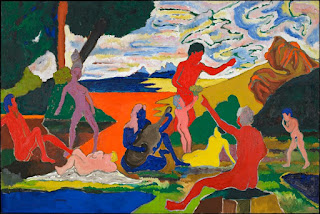The Koffler collection of Chicago art introduced me to Bob Thompson (1937-1966) almost ten years ago. It had just been donated to the Depaul Art Museum which immediately put some selected pieces on display. Thompson never lived anywhere nearby , so why was he included among all the distinguished Chicago artists? Perhaps the Kofflers wished he really had worked here - and so do I. He did for Old Master European painting what jazz was doing for American musical theater: transforming a strong narrative tradition into a platform for personal virtuosity and self expression. What a surprise in the context of postwar American art! And what a challenge to carry it off with elegance and style - while still preserving just enough of the narrative to keep it comprehensible and compelling.
The Thompson story is both magic and tragic. His career began at the University of Louisville where Charles Crodel, a German expressionist painter and designer of stained glass windows, was a visiting professor. He was probably responsible for linkingThompson to the European tradition as well as the simplified figurative style he would adopt. Soon after graduation, Thompson was having solo shows in New York City, hanging out with the poet, LeRoi Jones (Amiri Baraka) , and hearing, if not jamming with, some of the most progressive jazz artists of the day. (Thompson played drums). The exhibit includes a portrait of the Jones family, as well as “The Garden of Music”, a wall size landscape with cameo portraits of his musical friends or heroes: John Coltrane, Ornette Coleman, Don Cherry, Sonny Rollins and Charlie Haden among others. His paintings were selling, he was making hundreds of them, and he was moving through Europe, visiting art museums and riffing on what he had seen. Then suddenly it all stopped. He was dead at the age of 28.
The portraits mentioned above are interesting mostly for their subject matter. Thompson’s figure drawing was more about pictorial space than figurative expression. The personal nature of the portraits interrupted his sense of space, so the pieces are left feeling awkward and clumsy. Gallery signage suggests that the portrait of the Jones family is unfinished. Occasionally, that clumsiness is felt elsewhere in the show. Thompson may have thought of his paintings as improvisations. Some are hits - some are misses - it doesn’t matter - just move on to the next song on the playlist.
His figures are silhouettes filled in with solid color, much like Matisse. Their contour lines usually lack that early Modernist’s athletic energy and inner life - but the deep surrounding space is so much more ebullient and disruptive. There’s the joy of astonishing disharmony - much like the music of Thelonious Monk. But is there any narrative content worth noting? Gallery signage tells that ”he distorts those received forms in ways that both compound their ambiguity and reveal their relevance to contemporary concerns in the United States from civil rights to freedom of expression to sexual liberation”. But that sounds way too political for the light hearted playfulness that is so upfront. If you ask “what is going on here?” , you will invoke the thrill of absurdity rather than the recognition of some profound theme. In the paintings that riff on Goya’s “Caprichos”, contempt and scorn is replaced by goofiness. The oversized birds and looming, silly monsters recall the world of children’s puppet theater - though the recurring demarcation of the pubic area, suggest work made by, rather than for, children. There is little especially profound here other than the buoyancy of the artist’s spirit. That’s the most important quality that Thomson’s work shares with the Old masters that he drew from. It might also be seen as an outsider's view of the Euro-Centric imagination - but it remains Euro-Centric, and patriarchal, none the less.
*****************
Homage to Nina Simone
A magnificent, psychedelic mess, the swirling visual incongruities here keep the viewer continually off balance.
Nina Simone is the naked, pelvic-thrusting lady standing to the left. She is colored purple, not black, so we know that racial politics are not an issue. This is not Kerry James Marshall.
Black Monster
In an online video about this painting, Nicole Bond, Smart Museum Lead Educator, points out that scholars have expressed "opinions which equate the large pointed toothed beast to one of the most feared yet envied human attributes: black male sexuality" And it certainly appears that this amorous monster is hunting white girls, not black ones.
Here's another image of a dark creature hunting a naked white girl - this one being used to promote one of his exhibitions.
It's not a theme that dominates Thompson's work - but he does occasionally visit American attitudes towards inter-racial sex. Like LeRoi Jones, Thompson married a white woman.
************
Dmitry Samarov has also reviewed the show in the Chicago Reader.
His piece is more of an ecomium - but as an effective figurative painter himself, everything he says about the figure painting of others is interesting.
Diane Thodos has some interesting things to say about the blank faces, paradise, and the expressionist painter, Jan Muller.





No comments:
Post a Comment